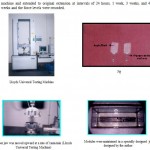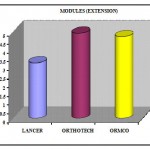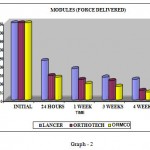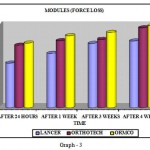Manuscript accepted on :
Published online on: --
Orthodontic Force Induced by a Single Elastomeric Module at Different Intervals of Time
S. Kishore Kumar and A. Julius
Department of Orthodontics, Sree Balaji Dental College and Hospital, Bharath University, Narayanapuram, Pallikaranai - 600 100, India.
DOI : http://dx.doi.org/http://dx.doi.org/10.13005/bbra/1079
ABSTRACT:
In this study commercially available single elastomeric module of three different companies for their force degradation were compared over a period of four weeks and the degree of stretch required for a single elastomeric module to deliver an optimum sustained orthodontic force were determined.
KEYWORDS: Elastomeric module; Force Decay; Optimal Orthodontic Force; Stretch, Jig.
| Copy the following to cite this article: Kumar S. K, Julius A. Orthodontic Force Induced by a Single Elastomeric Module at Different Intervals of Time. Biosci Biotech Res Asia 2012;9(2) |
| Copy the following to cite this URL: Kumar S. K, Julius A. Orthodontic Force Induced by a Single Elastomeric Module at Different Intervals of Time. Biosci Biotech Res Asia 2012;9(2). Available from: https://www.biotech-asia.org/?p=10211 |
Introduction
All orthodontic force systems requires optimum energy for the efficient tooth movement. Hyalinized cell free (Reitan. K) zone is avoided or minimized by using light continuous force. Elastomeric Chains are composed of polymers that contain urethane linkage. Elastomeric chains are (De Genova D.C. et al) known for rapid force (Hershey H.G et al) decay of 50 to 75 % (Baty D.L . et al) in the first 24 hours. Over stretching, gradual stretching, and pre-stretching (Von Fraunhofer J.A., et al) has been advocated to overcome the problem. Few studies focus on a single elastomeric module (Bennett J.C et al) for canine retraction. There is no clear indication as to how much stretch is necessary to provide sustained optimum force.
Materials and Methods
A total number of 30 samples of elastomeric modules of three different companies (10 samples/ company) were selected for the test to evaluate the degree of stretch required to deliver the optimum orthodontic force and later force decay in 4 weeks.
A Llyods universal testing machine was used for the purpose of extension. The jig consists of an acrylic block to which a SS hook was attached. One of the jig was attached to the upper and the other jig to the lower jaw of universal testing machine. A piece of ligature was attached to the module and twisted. The free end of the ligature was later embedded in an acrylic block which was then attached to the lower jaw of the testing machine. The upper jaw was moved at a rate of 1mm/min. The amount of extension for each sample for each company to deliver a force of 450 gms is noted as displayed in the digital extension indicator and then the mean value is calculated for each company.
 |
Figure 1
|
To calculate the force decay the modules were stretched to the mean value previously obtained and maintained with the help of a specially designed jig by the author in an artificial salivary medium (Von Fraunhofer J.A. et al). Thereafter modules were returned to the testing machine and extended to original extension at intervals of 24 hours, 1 week, 3 weeks, and 4 weeks and the force levels were recorded.
Results
The statistical software SPSS was used for statistical analysis. One way ANOVA, multiple range test by Duncan procedure and student paired t – test were employed to find statistical difference between groups. The results are as follows;
The mean and standard deviations of force along with mean extension and percent force loss of all modules at various time intervals are given below:
| Time | N | ORTHO TECH | LANCER | ORMCO | |||||||||
| Force delivered (±) S.D | Extension in mm | Percent loss from initial | Percent loss at consecutive interval | Force delivered (±) S.D | Extension in mm | Percent loss from initial | Percent loss at consecutive interval | Force delivered (±) S.D | Extension in mm | Percent loss from initial | Percent loss at consecutive interval | ||
| Initial | 10 | 447.482 ± 9.43 | 4.911 | – | – | 449.905 ± 0.2047 | 3.193 | – | – | 451.502 ± 16.475 | 4.709 | – | – |
| 24 hrs | 10 | 141.924 ± 15.637 | 4.911 | 68.31% | 68.31% | 229.407 ± 1 4.556 | 3.193 | 49% | 49% | 132.2 ± 9.62 | 4.709 | 70.71% | 70.71% |
| 1week | 10 | 119.218 ± 26.353 | 4.911 | 73.38% | 15.99% | 182.82 ± 40.2546 | 3.193 | 59.36% | 20.3% | 95.55 ± 11.53 | 4.709 | 78.83% | 27.72% |
| 3week | 10 | 112.26 ± 27.62 | 4.911 | 74.94% | 5.83% | 133.06 ± 28.898 | 3.193 | 70.42% | 27.21% | 79.39 ± 22.465 | 4.709 | 82.4% | 16.91% |
| 4week | 10 | 55.61 ± 5.64 | 4.911 | 87.58% | 50.46% | 121.1 ± 26.956 | 3.193 | 73.08% | 8.98% | 45.82 ± 6.714 | 4.709 | 89.85% | 42.28% |
 |
Graph 1
|
 |
Graph 2
|
The graph – 1 and table – 1 shows the mean extension values of various modules: Orthotech(4.911mm), Lancer(3.193mm) and Ormco(4.709mm), such that a force delivery of 450 gms level was attained.
Table – 1 and Graph -2 shows the force delivered by the modules at various durations of time.
Table – 1 and Graph – 3 shows the force loss by the modules of different companies. At the end of 4 weeks, Ormco showed maximum force loss of 89.85%, followed by Orthotech 87.58% and Lancer 73.08%. During the first 24hours all modules showed significant degradation. Ormco and Orthotech showed significantly greater degradation than Lancer.
Between the intervals of 24 hours to 1 week all modules individually showed significant force degradation, while comparison revealed no significant difference. Between the interval of
 |
Graph 3
|
1st and 3rd week only Lancer module showed a significant degradation. However, the residual force exerted by the Lancer module at the end of 4 weeks was still greater.
Discussion
The initial force was fixed at 450gms because the force loss (Louis J. Taloumis et al) of 50 to 75% (Hershey H.G et al) was anticipated in the first 24 hours. At the end of 4 weeks the overall percentage of force loss for Ormco (89.85%) was greater than, Orthotech (87.58%) and Lancer (73.08%) modules. First 24 hours Lancer module displayed least force loss of 49% compared with Orthotech 68.31% and Ormco 70.71% in accordance with Hershey and Reynolds, (Rock W. P et al) and many others. Ormco modules showed significant force loss during all the intervals. The Lancer module begins to loose significant force in the 3rd week and the Orthotech module in the 4th week. Elastic stretch and chain slippage are responsible (Kyung—Ho Kim et al) for the rapid force decay (Stevensons J.S. et al). Very few studies have focussed on a single elastomeric module (Bennett J.C. et al) as recommended in recent years.
From this study it was noted that Orthotech module delivered a required force for 3 weeks when extended to 4.911mm (160% of its original length) in accordance with Kanchana et al, Lancer 3.193mm (106% of its original length) for 4 weeks and Ormco 4.709mm (157 % of its original length) for 1 week , in contrast with various authors recommending of extending it to 90 – 75% (Rock et al) 52-57% initially and after 24 hours 20-40% again (Baty et al), and increase of only a third (Allen K. Wong).
Summary
The different modules showed a significant force decay with increase in time and the amount of stretch required was found to be directly proportional to the force decay. Orthotech module was found to be effective till three weeks, lancer was effective till four weeks and Ormco was effective till one week.
References
- Allen K.Wong. Orthodontic elastic materials. Am. J. Orthod. 1976; 46:196-205.
- Baty D.L. Storie D.J.,Von Fraunhofer. Synthetic elastomeric chains: A literature review. Am. J. Orthod. Dentofac. Orthop. 1994;536-542.
- Baty D.L., Jhon E.V., Von Fraunhofer. Force delivary of coloured elastomeric modules. Am. J. Orthod. Dentofac. Orthop.1994;106:40 -46
- Bennett J.C ., Mclaughlin R.p. controlled space closure with a preadjusted appliance J. Clin. Orthod. 1990 ;251-260.
- Chung P.C.K.., Wei S.H.Y., Reynolds I.R. In vitro testing of elastomeric modules. J. Orthod. 1989; 16: 265-269.
- De Genova C., mcInnes – Ledous P., Weinberg R., Shaye R. Force degradation of orthodontic elastomeric chains – A product comparison study. Am. J. Orthod. Dentofac. Orthop. 1985; 87: 377-384.
- Hershey H.G. Reynolds W.G. the plastic module as an orthodontic tooth-moving mechanism. Am. J. orthod. 1975; 67: 554-562.
- Kanchana P., Godfrey K. Calibration of force extension and force degradation characteristics of orthodontic latex elastics. Am. J. Orthod. Dentofac. Orthop. 2000: 118: 280-287.
- Kyung—Ho Kim, Chun-Hsi Chung,Kwnagchul Choy Jeong-Sub Lee, Robert L.Vanarsdall., Effects of prestretching on force degradation of synthetic elastomeric chains. Am j orthod Dentofacial orthop 2005;128:477-82.
- Louis J.Taloumis, Terrence M.Smith, Steven O.hondrum, Lewis Lorton,. Force Decay and deformation of orthodontic elastomeric ligatures. . Am j orthod Dentofacial orthop jan 1997; 111:1:1-11.
- Reitan K. Some factors determining the evaluation of forces in orthodontics. Am. J. Orthod. 1957; 43: 32-45.
- Reitan K. Some factors determining the evaluation of forces in orthodontics. Am. J. Orthod. 1957; 43: 32-45.
- Rock W.P., Wilson H.J., Fisher S.E. A laboratory investigation of orthodontic elastomeric chains. Br. J. Orthod. 1985; 202-207.
- Rock W.P., Wilson H.J., Susan E. Fischer. Force reduction of orthodontic elastomeric chains after one month in the mouth. Br. J. Orthod. 1986; 13: 147-150.
- Stevenson J.S., Kusy R.P. Force application and decay characteristics of untreated and treated polyurethane elastomeric chains. Angle Orthod. 1994; 64: 455-467.
- Von Fraunhofer J.A., Coffelt M.T.P., Orbell G.M. The effect of artificial saliva and topical fluoride treatments on the degradation of the elastic properties of orthodontic chains. Angle Orthod. 1992; 62: 265-274.

This work is licensed under a Creative Commons Attribution 4.0 International License.





